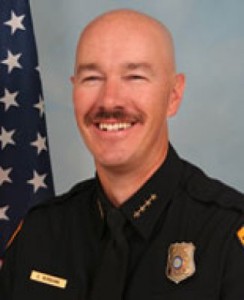A Leader Who Exemplifies The Value of Service
I remember when police officers lived by the motto of “To Serve And Protect.” Back then they were viewed as part of the community. Everyone felt safe around them.
Sadly, today it feels as if the community often fears the police. It’s not just the fact they hide and wait to catch speeding motorists, or randomly stop people to check for a valid driver’s license. In many cities across America, police are quick to apply aggressive tactics, even during peaceful protests.
Just consider the Occupy movement of recent years. How often has the news media shown us the violent clashes between protestors and police? We see the police outfitted with riot gear – vests, helmets, leg and arm pads – and branding riot sticks meant to beat back protestors.
What happened to the police who serve and protect?
 Thankfully, there are a few leaders trying to change that perception.
Thankfully, there are a few leaders trying to change that perception.
One well-respected leader is Chris Burbank. Since 2006, he’s been the Chief of Police in Salt Lake City, Utah.
To help reform the type of policing in his city, Chief Burbank has clearly embraced the differentiating value of Service, which means an act of help or assistance; work that benefits another.
As an example, when the police needed to evict the Occupy protesters in their city, Chief Burbank and his officers wore their standard, everyday uniforms, not riot gear. And the first person on the scene to talk to the protestors was none other than Chief Burbank himself.
The police even offered to help the protestors remove their belongings. With no violence or riots, they proved that this new (old) model of policing works well.
That’s real service in action!
Contrary to how police elsewhere often operate, Chief Burbank encourages using the minimum amount of force necessary to resolve a situation. While not everyone agrees with his approach, even calling it unconventional, he’s proud of it and continues to promote it.
As the Huffington Post so beautifully reported, Chief Burbank thinks differently than other police chiefs. Just consider a few of his comments quoted in the article:
- “As police officers, our goal should always be to use the lowest possible level of force to fulfill our responsibilities.”
- “I just don’t like riot gear… It invites confrontation. Two-way communication and cooperation are what’s important. If one side overreacts, then it all falls apart.”
- “We’re not the military. Nor should we look like an invading force coming in.”
- “If the police show up and the situation deteriorates, then that’s our fault. We haven’t done our job right.”
- “If my officers feel unsafe, that’s when it’s my responsibility as a chief to show up personally.”
- “We should be asking, what’s the least amount of force we can get away with here, and still be safe?”
- “It’s not can I do it, but should I do it?”
- “Police today get too much training in how to use different types of force, but too little training on conflict resolution.”
To help put the value of service back into the motto, “To Serve and Protect”, Chief Burbank highlights his two key objectives:
- “We need to humanize our police forces. We aren’t an occupying force. We are part of the community.”
- “One of the most important traits in a good police officer is empathy.”
What a great note to end on.
Consider the impact on policing overall if all potential police officers were recruited for the value of empathy…
Have you had a positive experience with the police where they demonstrated the value of service?
Today’s value was selected from the “Determination-Focus” category, based on the e-book Developing Your Differentiating Values.







